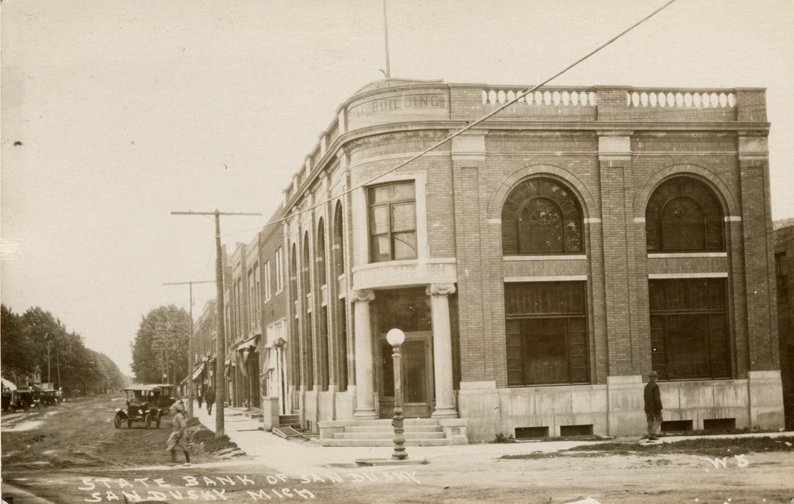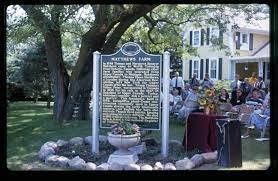
Sanilac County History
Museums
International harvester collection
Local history museum in Deckerville, MI, offering an old fashioned General Store, Post Office, Military Room, Indian/Native American Artifacts, Family & Business History, School & Church Memories, Research Room, Farm/Barn Area, and more!
Restored train station museum.
The Sanilac County Historic Village and Museum is a collection of more than a dozen historic buildings located on ten acres of the original Dr. Joseph Loop estate in the Lake Huron harbor village of Port Sanilac. The Sanilac County Historical Society invites you to step back in time as you wander through the beautiful gardens and the Victorian, Edwardian, and vintage buildings and exhibits that are featured on the property.
Historical Markers
The tug Sport, one of the nation’s earliest steel-hulled vessels, was built for lumber and steel entrepreneur Eber Brock Ward in 1873 by the Wyandotte Iron Ship Building Works in Wyandotte, Michigan. For forty-seven years the tug towed, salvaged, and aided vessels in distress. Frank E. Kirby designed the tug and later became a nationally known naval architect recognized for designing large, elegant sidewheel passenger steamers and ice-breaking car ferries, such as Chief Wawatam.
Named after early settler Edward Cash, the village of Cash was founded in 1851. In 1868, seven Cash residents voted to found Watertown Township to govern and serve the quickly growing area. Each man who voted held at least one township post. In 1881, Cash survived wildfires that swept across the entire county in five hours. The arrival of the railroad in nearby Watertown in 1912 ended Cash’s role as an important commercial center in the region.
In 1848 Thomas and Margaret Spencer Matthews came to Worth Township from Ontario, Canada, following other farm families who migrated from Upper Canada to Michigan. Matthews’s grandfather, Thomas Elmes Matthews, a Loyalist during the American Revolution, left New York for Upper Canada after the war. Young Thomas’s father, Peter, was executed in Toronto in 1838 for his role in the 1837-38 Rebellion of Upper Canada. Today historians consider him a patriot and a martyr.
This tall stately Gothic Style church with its elegant wood interior was built in 1874 during Sanilac County’s great lumbering era. The Reverend A. B. Flower came to Lexington as a missionary in 1869 and started this congregation known as the Church of the Good Shepherd. Among its active members was Mary Moore who married Albert Sleeper, governor of Michigan from 1917 to 1920. Sleeper served as vestryman and warden of the church until moving to Bad Axe. Since 1972 this has been the Lexington Chapel of Trinity Episcopal Church.
This Second Empire style mansion was built in the 1870s by Doctor Joseph Loop. A native of New York, Loop moved to Oakland County, Michigan, in 1843. He and his wife, Jane Gardner Loop pioneered this land in Sanilac County in 1854, and after graduating from the University of Michigan’s medical department in 1855, he opened a practice in Port Sanilac. When this home was built, he kept an office on the lower floor, and serviced a forty-mile circuit, bringing medical care to much of the county.
This picturesque cobblestone building constructed in 1898 serves as the Croswell chapel of the Trinity Episcopal Church. Its interior features wooden arches and a rood screen between the nave and the chancel.
Sudden tragedy struck the Great Lakes on November 9, 1913, when a storm, whose equal veteran sailors could not recall, left in its wake death and destruction.
Published under the motto “Our Community is our Hive. The Rights of the People, our Queen,” The Brown City Bee debuted on January 23, 1891. Owner James A. Menzies named the newspaper for the “business-like fellow” who ensures “that matters are kept `humming’ about him.” He renamed the paper The Brown City Banner in December 1891.
The Sanilac Masonic Lodge was organized in 1868. In 1883 lodge members and township officials agreed to build a combined township and Masonic hall on land donated by Christopher Odfield, a Mason. The foundation was built with three-foot-thick walls to provide refuge from future forest fires. When the cornerstone was laid on July 1, 1884, crowds turned out for the event, which was highlighted by Masonic ritual.
The first twenty-five miles of track for the Port Huron and Northwestern Railroad opened from Port Huron to Croswell in 1879. Marlette citizens lured the railroad by raising $15,000 toward construction of the tracks. The line extended from Saginaw Junction in St. Clair County to Marlette in January 1881, and the Marlette to Mayville line opened in the fall.
This handsome building was the first church erected in Buel Township. Known as the Buel United Methodist Church, it was dedicated on December 3, 1882.
The village of Lexington and the local Masonic Lodge combined their efforts and finances to build this three-story Italianate structure in 1876. The village owned the first two floors (the fire department and the opera house); the Masons, the third floor.














